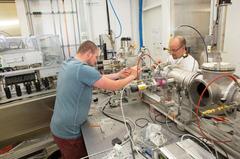URL: https://www.desy.de/news/news_search/index_eng.html
Breadcrumb Navigation
DESY News: User operation at first PETRA III extension beamline
News
News from the DESY research centre
User operation at first PETRA III extension beamline
The first undulator beamline of the new PETRA extension north took up regular user operation in early June. Beamline P65, offering the so-called X-ray absorption spectroscopy (EXAFS) technique, is now open to groups of scientists. Just like for the beamlines in the experimental hall “Max von Laue”, scientists have to apply for beamtime in a review process. “Three and a half years after the shutdown of DORIS we can now offer a dedicated EXAFS beamline again,” says Edmund Welter, who oversees the beamline P65. “Many researchers have been eagerly awaiting this moment.”

Two users at the new PETRA III beamline P65 install the gas lines at the cell for catalytic samples.
The first users of P65 came from the Karlsruhe Institute of Technology and the University of Paderborn. With the help of the PETRA III light they checked in which way their catalyst samples age during operation, to find out what is the ideal geometry and process of application of the catalytic material on a support structure. “By means of X-ray absorption spectroscopy one can selectively improve the efficiency of industrial catalysts,” explains Edmund Welter. “For example, nowadays car catalysts include much less of the expensive noble metals than in the past, but they perform much better.”
While the beam time is assigned to the scientists at P65 until the end of the year, the other beamlines in the PETRA III extensions are built. Already this year, first experiments on the adjacent beamline P64 are supposed to be carried out. In Extension Hall East new beamlines will be put into operation in spring 2017. “With the regular user operation at P65, the expansion of PETRA III has reached an important milestone,” says Wolfgang Drube, project manager for the PETRA extensions. “We are now working flat out to build the additional beamlines, without interfering with the current user operation at the other beamlines.”



